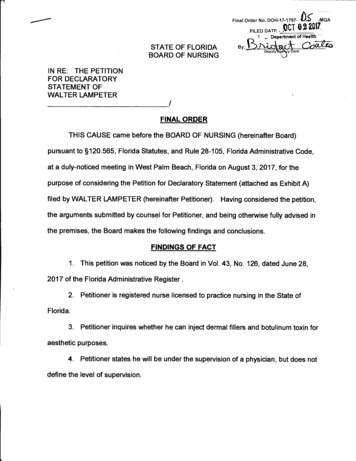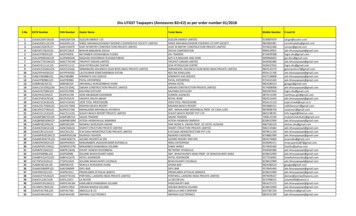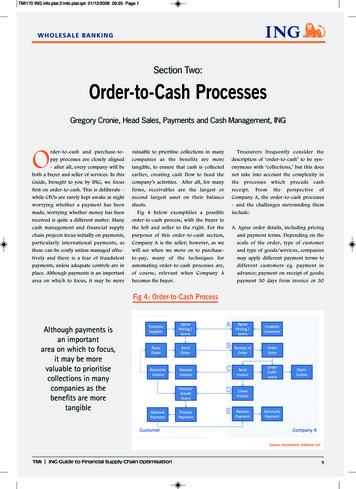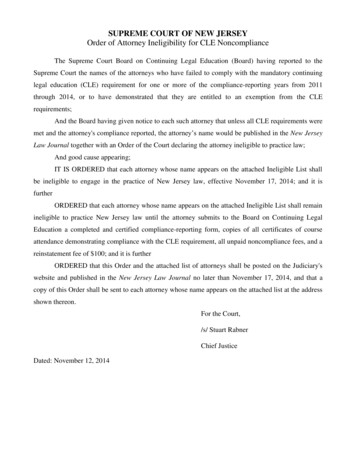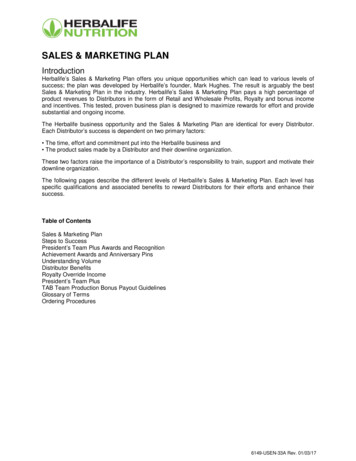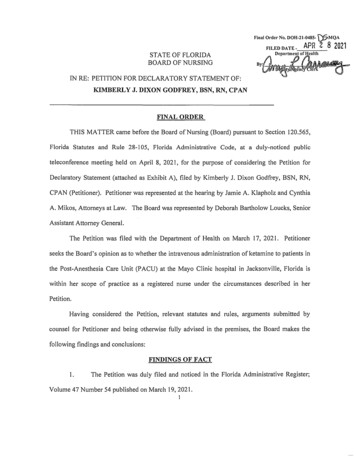
Transcription
Final Order No. DOH-21-0485- \)5-MQAFILED DATE-STATE OF FLORIDABOARD OF NURSINGIN RE: PETITION FOR DECLARATORY STATEMENT OF:APR 2 8 2021.,an;i: '-----llKIMBERLY J. DIXON GODFREY, BSN, RN, CP ANFINAL ORDERTHIS MATTER came before the Board of Nursing (Board) pursuant to Section 120.565,Florida Statutes and Rule 28-105, Florida Administrative Code, at a duly-noticed publicteleconference meeting held on April 8, 2021, for the purpose of considering the Petition forDeclaratory Statement (attached as Exhibit A), filed by Kimberly J. Dixon Godfrey, BSN, RN,CPAN (Petitioner). Petitioner was represented at the hearing by Jamie A. Klapholz and CynthiaA. Mikos, Attorneys at Law. The Board was represented by Deborah Bartholow Loucks, SeniorAssistant Attorney General.The Petition was filed with the Department of Health on March 17, 2021. Petitionerseeks the Board's opinion as to whether the intravenous administration of ketamine to patients inthe Post-Anesthesia Care Unit (PACU) at the Mayo Clinic hospital in Jacksonville, Florida iswithin her scope of practice as a registered nurse under the circumstances described in herPetition.Having considered the Petition, relevant statutes and rules, arguments submitted bycounsel for Petitioner and being otherwise fully advised in the premises, the Board makes thefollowing findings and conclusions:FINDINGS OF FACT1.The Petition was duly filed and noticed in the Florida Administrative Register;Volume 47 Number 54 published on March 19, 2021.1--
2.The Petition is attached hereto and incorporated herein by reference.3.Petitioner, Kimberly J. Dixon Godfrey, BSN, RN, CPAN is a registered nurselicensed to practice nursing in the State of Florida, having been issued license numberRN 1800002. She has been licensed as a registered nurse in the State of Georgia since 2016.4.Petitioner is the PACU RN Team Lead at the Mayo Clinic in Jacksonville, aposition she has held since 2016. Additionally, she has over 22 years of experience as a PACUnurse.5.Petitioner is certified in Advanced Cardiac Life Support. She is a Certified Post-Anesthesia Nurse (CPAN) through the American Board of Perianesthesia Nursing Certification.6.The Mayo Clinic-Florida uses subanesthetic ketamine for postoperative analgesiaand all registered nurse in the all clinical units are trained to monitor and care for patientsreceiving ketamine therapy.The pharmacy department prepares the ketamine infusions and"smait" pump infusion devices with "guardrail" technology to reduce the likelihood ofprogramming and dosing errors.7.Petitioner inquires if it is within her scope of practice as an RN at Mayo Clinic-Florida to administer ketamine to patients in a PACU under each of two circumstances:a. to administer a continuous ketamine infusion intravenously in a dose of 0.05 to 0.25mg/kg/hr. to a non-intubated patient in the PACU for the purpose of pain management pursuantto an Anesthesia Provider's order when an Anesthesia Provider is present in the Integrated Unitand immediately available in accordance with Mayo Clinic approved treatment protocols.b. to administer an initiating/loading dose of 0.25 to 0.5 mg/kg (not to exceed 35mg) ofketamine intravenously at the onset of a continuous ketamine infusion to a non-intubated patientin the PACU for the purpose of pain management pursuant to an Anesthesia Provider's order2
when an Anesthesia Provider is present in the Integrated Unit and immediately available inaccordance with Mayo Clinic approved treatment protocols.CONCLUSIONS OF LAW8.The Board has jurisdiction over this matter pursuant to section 120.565, andChapter 464, Florida Statutes.9.The petition filed in this matter is in substantial compliance with the provisionsof Section 120.565, Florida Statutes and Rule 28-105, Florida Administrative Code.l 0.Section 464.003(19), Florida Statutes, defines the practice of professional nursing,in part, asthe performance of those acts requmng substantial specialized knowledge,judgment, and nursing skill based upon applied principles of psychological,biological, physical, and social sciences which shall include, but not be limitedto:b. The administration of medications and treatments as prescribed or authorizedby a duly licensed practitioner authorized by the laws of this state to prescribesuch medications and treatments.11.The Board found the under the specific facts of the petition, it is within the scopeof Petitioner's specific and particular education, training and experience to administer ketaminein the two circumstances set forth above.DONE AND ORDERED this 28 th day of April, 2021.BOARD OF NURSINGJ irectorfor Deborah McKeen, CD-LPN, BS, Chair3
NOTICE OF RIGHT TO JUDICIAL REVIEWA party who is adversely affected by this Final Order is entitled to judicial reviewpursuant to Section 120.68, Florida Statutes. Review proceedings are governed by the FloridaRules of Appellate Procedure. Such proceedings are commenced by filing one copy of a Noticeof Appeal with the Agency Clerk of the Depaitment of Health and a second copy, accompaniedby filing fees prescribed by law, with the District Court of Appeal, First District, or with theDistrict Court of Appeal in the Florida Appellate District where the party resides. The Notice ofAppeal must be filed within thirty (30) days of rendition of the order to be reviewed.CERTIFICATE OF SERVICEI HEREBY CERTIFY that a true and correct copy of the foregoing was furnished toKimberly J. Dixon Godfrey, BSN, RN, CPAN by sending same by electronic mail to: herattorneys of record,Jamie A. Klapholz, iamiek@jpfirm.com; and Cynthia Mikos,cynthiam@jpfirm.com; and Deborah B. Loucks, Senior Assistant Attorney General,deborah.Ioucks@myfloridalegal.com, and Angela Southwell, Paralegal Specialist, Office of .com,, J ., ------.,b -------' 2021.,, "------'i '-- :::,4on
4434FILEDDEP.ARTlWENT OF :HEALTHDEPUTY CLERKCLERK: B, e,f- DAT :M R 1 7 2021FLORIDA DEPARTMENT OF HEALTHBOARD OF NURSINGPetition for Declaratory StatementBefore the Board of NursingIn re: Kimberly J. Dixon Godfrey, BSN, RN, CPAN----------------- /Petitioner, Kimberly J. Dixon Godfrey, RN, by and though the undersigned attorneys andpursuant to section 120.565, Florida Statutes and Florida Administrative Code Rule 28-105.002,seeks the Florida Board of Nursing's ("Board") opinion as to whether the intravenousadministration of ketamine to patients in the Post-Anesthesia Care Unit ("P ACU") at the MayoClinic hospital in Jacksonville, Florida ("Mayo Clinic-Florida") is within her scope of practice asa registered nlll'se ("RN") under the circumstances described herein.1.Petitioner, Kimberly J. Dixon Godfrey is a registered nurse ("RN") licensed bythe Florida Board of Nursing pursuant to Florida Statutes Chapter 464 holding license numberRN1800002 since 1987. Ms. Godfrey has also been licensed as an RN in the State of Georgiasince 2016. She can be contacted through undersigned counsel.2.Ms. Godfrey is currently employed at Mayo Clinic-Florida, where she has servedas the PACU RN Team Lead since 2016. In this role, Ms. Godfrey is responsible forpreoperative patient care, all PACU phases, and RN sedation. Ms. Godfrey has over 22 years ofexperience as a PACU nurse. Ms. Godfrey's cuniculum vitae is enclosed as Exhibit 1.3.Ms. Godfrey holds Advanced Cardiac Life Support ("ACLS") certification fromthe American Heart Association. In addition, she is a Certified Post-Anesthesia Nurse ("CP AN")through the American Board of Perianesthesia Nursing Certification, Inc. Ms. Godfrey currentlyserves as the president of the Florida Society of Peri.anesthesia Nurses. As an active member of1
4435the American Society of Perianesthesia Nurses, she has devoted significant time and effort to theadvancement of her profession for many years.4.As detailed in an article published in the Journal of PeriAnesthesia Nursing inJune of 2015, Mayo Clinic-Florida has successfully used subanesthetic ketamine for postoperative analgesia for many years. 1 Though RNs do not presently administer ketamine to nonintubated patients at Mayo Clinic-Florida, RNs in all clinical units are trained to monitor andcare for patients receiving ketamine therapy. 2 The phannacy department prepares the ketamineinfusions and "smart" pump infusion devices with "guardrail" technology are used to administerthe ketamine infusions to reduce the likelihood of programming and dosing errors. 35.Mayo-Clinic Florida contains two PACUs that are each connected to a pre-operative area and operating rooms (collectively, the "Integrated Unit"). The First-FloorIntegrated Unit consists of seven operating rooms and roughly 14 PACU beds. The Fourth FloorIntegrated Unit currently consists of 19 operating rooms and 36 PACU beds but is beingrenovated for an expansion to 34 operating rooms and 50 P ACU beds. An anesthesiologist,anesthesia resident physician, or certified registered nurse anesthetist (collectively, "AnesthesiaProvider") remains on duty in the Integrated Unit at all times when there is a patient in theIntegrated Unit.6.At Mayo Clinic-Flo1ida, intubated patients in the PACU are extubated as soon aspossible because prolonged intubation carries numerous risks. However, extubated patients in theP ACU often remain in significant pain and require sufficient and timely pain relief to maintainstability. For this population of patients, Mayo Clinic-Florida's Anesthesia Providers will often1 Porter, McClain, Howe, et al, Perioperative Ketamine for Acute Postoperative Analgesia: The Mayo ClinicFlorida Experience, 30 Journal of PeriAnesthesia Nursing 3, 189-195 (June 2015).2 Id at 194.3Id at 193.2
4436order subanesthetic ketamine because of its ability to produce a state of analgesia withoutcausing hypotension or respiratory depression. 47.At Mayo Clinic-Florida, some patients a1Tive in the PACU from the operatingroom with low-dose ketamine infusions already in progress. When the ketamine infusion isestablished in the PACU, RNs (including Ms. Godfrey) will routinely "set up" the "smart" pumpinfusion devices by entering the patient's weight and the ordered ketamine dose. Then, due to thelack of clarity about the RN's ability to initiate the ketamine infusion, the patient must wait for aphysician or advanced practice provider to come press the start button to begin to the ketamineinfusion. Though an Anesthesia Provider is always on duty in the Integrated Unit when a patientis in the PACU, the Anesthesia Provider may be preparing another patient in the pre-operativearea, administering anesthesia in the operating room, or evaluating another patient's condition inthe PACU. The Anesthesia Provider is immediately available to respond to an emergent eventbut may not be able to immediately initiate a low-dose ketamine infusion. This becomesespecially problematic during the evening shift when fewer Anesthesia Providers are generallyon duty.8.The Mayo Clinic Health System maintains an order set titled Ketamine Low DoseInfusion that provides for continuous cardiac monitoring and pulse oximetry, as well as routinevital sign monitoring. This order set also provides for the supervising provider to be notified if apatient's respiratory rate, Richmond Agitation and Sedation Scale ("RASS") scores, oroxygenation saturation fall outside of specified parameters. The supervising provider is also to benotified if the patient experiences confusion, delirium, or hallucinations.4Brown and Tucker, Ketamine for Acute Pain Management and Sedation, 40 Critical Care Nurse 5, e26 (Oct.2020).3
44379.At the Mayo Clinic Health System's campuses in Minnesota and Arizona, RNsare permitted to administer ketamine pursuant to guidance issued by the boards of nursing inthose states and in accordance with the Mayo Clinic's Intravenous Administration Guidelines("I-VAG"), a copy of which is enclosed as Exhibit 2. Mayo Clinic's Pharmacy & TherapeuticsExecutive Committee developed the I-VAG based on extensive review of data, clinicalindications for ketamine, and the Minnesota Board ofNursing's Statement of Accountability forAdministration of Jvledications Classified as Anesthetics by the Reg;.stered Nurse adopted inOctober 2005 and reaffirmed in October of 2016.10.The Mayo Clinic Health System is attempting to standardize order sets andtreatment protocols throughout its locations.11.Ms. Godfrey seeks the Board's determination as to whether it is within her scopeof practice as an RN at Mayo Clinic-Florida to administer ketamine to patients in the PACUunder each of the following two circumstances:(a) Ms. Godfrey seeks the Board's determination as to whether it is within her scopeof practice as an RN to administer a continuous ketamine infusion intravenouslyin a dose of 0.05 to 0.25 mg/kg/hr. to a non-intubated patient in the PACU for thepurpose of pain management pursuant to an Anesthesia Provider's order when anAnesthesia Provider is present in the Integrated Unit and immediately available inaccordance with Mayo Clinic approved treatment protocols.(b) Ms. Godfrey seeks the Board's determination as to whether it is within her scopeof practice as an RN to administer an initiating/loading dose of 0.25 to 0.5 mg/kg(not to exceed 35 mg) of ketamine intravenously at the onset of a continuousketamine infusion to a non-intubated patient in the P ACU for the purpose of painmanagement pursuant to an Anesthesia Provider's order when an AnesthesiaProvider is present in the Integrated Unit and immediately available in accordancewith Mayo Clinic approved treatment protocols.OVERVIEW OF RELEVANT MEDICAL LITERATURE12.Ketamine is approved by the United States Food and Drug Administration as anonbarbiturate anesthetic producing an anesthetic state characterized by profound analgesia,4
4438normal pharyngeal-laryngeal reflexes, normal or slightly enhanced skeletal muscle tone,cardiovascular and respiratory stimulation, and occasionally a transient and minimal respiratorydepression. 5 Ketamine is noted for its ability to produce a state of anesthesia while preservingrespiratmy drive and protective airway reflexes. 613.In low doses, ketamine has been shown to confer "potent, analgesic and amnesticeffects that are accompanied by preservation of protective airway responses, spontaneousrespiration and cardiopulmonary stability." 7 Low-dose ketamine is generally less than 1.0 mg/kgand sometimes referred to as a subanesthetic dose, subdissociative dose, or analgesic dose. 8 Inlow doses, ketamine has shown opioid-sparing effects which have made it a useful agent in manysituations, including for pain relief post-operatively, in palliative care settings, and for patientswith a tolerance to opioids. It is especially helpful when seeking to avoid the respiratorydepression associated with the use of opioids and benzodiazepines.14.In the PACU setting, low-dose ketamine is often used as a postoperativeanalgesic, especially for patients with chronic preoperative pain. 9 In the widely cited ConsensusGuidelines on the Use of Intravenous Ketamine Infusions for Acute Pain Management (the"Consensus Guidelines"), the authors note that commonly reported dosing regimens during theperioperative period include an initiating/loading dose of 0.1 to 0.5 mg/kg followed by aninfusion of 0.1 to 0.6 mg/kg per hour, concluding that ketamine infusions for acute pain inehydrochloride)injection.Availableat:https://www .accessdata.fda.gov/drugsatfda docs/label/2020/0 I 6812Orig I s046lbl.pdf (last accessed March 6, 2021 ).6Brown and Tucker, Ketamine for Acute Pain Management and Sedation, 40 Critical Care Nurse 5, e26 (Oct.2020).7Motov, Rockoff, Cohen, et al, Intravenous Subdissociative-Dose Ketamine Versus Morphine for Analgesia in theEmergency Department: A Randomized Controlled Trial, 66 Annals of Emergency Medicine 3,222 (Sept. 2015).8Id.9Porter, McClain, Howe, et al, Perioperative Ketamine for Acute Postoperative Analgesia: The Mayo ClinicFlorida Experience, 30 Journal of PeriAnesthesia Nursing 3, 190 (June 2015).5
4439generally not exceed 1 mg/kg per hour in settings without intensive monitoring. 10 The ConsensusGuidelines further recommend that subanesthetic ketamine be administered by an appropriatelytrained RN, who "can monitor the patient receiving ketamine infusions in subanesthetic ·dosesand change the infusion rate based on directions from the responsible physician." 1115.In October 2020, two Florida phannacists published a narrative review of medicalliterature concerning ketamine for the treatment of acute pain or facilitation of mechanicalventilation in the ICU. 12 In this narrative review, the authors discussed two studies in whichpatients received initiating/loading doses of 0.5 mg/kg of ketamine followed by continuousinfusions of 0.12 to 0.36 mg/kg per hour of ketamine for 48 hours, resulting in reducedcumulative doses of morphine and decreased patient nausea. 13FLORIDA LAW AND PREVIOUS FLORIDA BOARD OF NURSINGDECLARATORY STATEMENTS ON RN ADMINISTRATION OF KETAMINE16.Under Florida law, an RN's scope of practice includes the practice of professionalnursing. Section 464.003(19) of Florida Statutes defines the "practice of professional nursing" asfollows:.Practice of professional nursing" means the performance of those acts requiringsubstantial specialized knowledge, judgment, and nursing skill based uponapplied principles of psychological, biological, physical, and social scienceswhich shall include, but not be limited to:(a) The observation, assessment, nmsing diagnosis, planning, intervention, andevaluation of care; health teaching and counseling of the ill, injured, or infirm;and the promotion of wellness, maintenance of health, and prevention of illness ofothers.10 Schwenk ES, Viscusi ER, Buvanendran A, et al, Consensus Guidelines on the Use of Intravenous KetamineInfi1sions for Acute Pain Management From the American Society of Regional Anesthesia and Pain Medicine, theAmerican Academy of Pain Medicine, and the American Society ofAnesthesiologists, 43 Regional Anesthesia andPain Medicine 5, 460 (July 2018).11 Id. at 461,463.12 Brown and Tucker, Ketaminefor Acute Pain Management and Sedation, 40 Critical Care Nurse 5, e26-e33 (Oct.2020).13 Id at e26.6
4440(b) The administration of medications and treatments as prescribed orauthorized by a duly licensed practitioner authorized by the laws of this stateto prescribe such medications and treatments.(c) The supervision and teaching of other personnel in the theory and performanceof any of the acts described in this subsection.A professional nurse is responsible and accountable for making decisions that arebased upon the individual's educational preparation and expedence in nursing.(emphasis added).17.An RN's administration of ketamine is not directly addressed in Florida's NursePractice Act or associated regulations. In 2012, the Board proposed a regulation to govern thecircumstances under which an RN may administer conscious sedation, including the use ofketamine, but this proposed regulation was invalidated by an administrative law judge ("ALJ'') ina rule challenge proceeding. 14 The ALJ reasoned, among other things, that the Board did nothave authority to impose additional education/training requirements or otherwise limit the RN'sability to administer any medication ordered by a duly licensed practitioner because no suchlimitation is included the Nurse Practice Act. 1518.In a similar case a few years later, an ALJ reasoned that the Board's blanketstatement prohibiting RNs from injecting Botox was contrary to the expressed statutory policyallowing RNs to administer medications within their scope of practice (the ALJ explained that"Botox is a medication" and "injection is one of the methods of administration of amedication."). 1619.Upon information and belief, the Board first addressed whether an RN mayadminister ketamine nearly 20 years ago in its April 29, 2003 Final Order regardin
the Florida Board of Nursing pursuant to Florida Statutes Chapter 464 holding license number RN1800002 since 1987. Ms. Godfrey has also been licensed as an RN in the State of Georgia since 2016. She can be contacted through undersigned counsel. 2. Ms. Godfrey is currently employed at Mayo Clinic-Florida, where she has served
